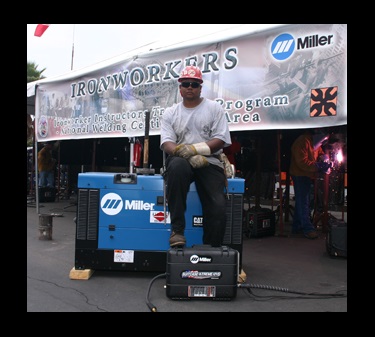 |
Gene “Red” Simmons, Local 229, San Diego, California, along with the tools of his trade.
|
Formal training standardizes the curriculum and techniques, and fosters sharing knowledge of new equipment that has been specifically designed for the ironworking industry. As a result, an apprentice in Salt Lake receives the same training as an apprentice in New Jersey.
“The training of the apprentices and the journeymen members of the Ironworkers Union is the lifeblood of our industry,” Ed Abbott said. “The people who are here this week are going to be training tomorrow’s future.”
Abbott is a general organizer with the Ironworkers International Union and manages the welding program and the National Welding Certification Program. He is also assistant to Mike White, who is the Executive Director of Apprenticeship and Training for the International Ironworkers headquarters.
“The object,” said Abbott,” is to bring the coordinators, instructors and business agents in from across the U.S. and Canada that train the apprentices and conduct the local journeyman upgrading classes. We give them the newest technology and make sure they’re trained in every facet of the industry so they can go back and transfer that information to the apprentices and journeymen.”
This year the Ironworkers trained on Miller’s latest welding technology with Miller’s XMT 350 CC/CV multi-process power source (matched with SuitCase X-Treme 12VS portable feeders) and CST 280 Stick/TIG power source, both in rack configurations, and the Dynasty 200 DX AC/DC Stick/TIG power source. All three incorporate Miller’s inverter technology, making them lighter, portable and more energy efficient, significantly reducing labor costs while allowing the contractor to complete jobs quicker then before.
During the training program, the trainers are able to test for their AWS/Ironworkers National Welding Certifications. The AWS/Ironworkers National Welding Certification is a combination of D1.1 structural steel and D1.5 bridge welding codes. The ironworkers test to the more stringent standards.
The certifications include SMAW on E7018 electrodes (Hobart’s 418) and FCAW with E7IT-8 wire in the 1G (flat position), 2G (plates vertical, axis of weld horizontal), 3G (vertical up), 4G (overhead) and 6GR (8” diameter pipe in fixed 45-degree angle with restrictor plate). By passing the vertical up and overhead position certifications, a welder is qualified in that process in all positions with unlimited thickness. By passing the 6GR certification, a welder is certified to weld in all positions, unlimited thickness, tube and plate.
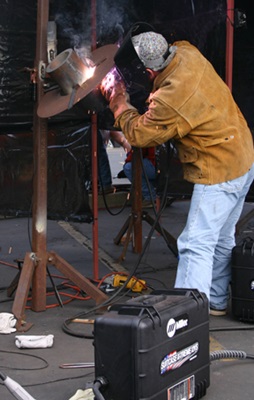 |
Testing on the 6G (8” diameter pipe in fixed 45-degree angle with restrictor plate). By passing the 6GR certification, a welder is certified to weld in all positions, unlimited thickness, tube and plate.
|
Welds are visually inspected and destructively tested by AWS-certified Ironworkers and Miller Electric welding inspectors and assessors who are on hand. The Ironworkers’ National Weld Testing and Certification Trailer contains saws and hydraulic presses to cut and bend the coupons. There is very little latitude given, and it doesn’t take much to reject a weld.
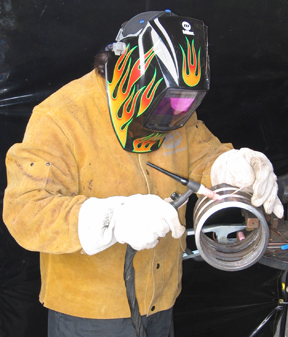 |
|
The Ironworkers train to meet the ever-increasing demand for TIG welders.
|
There has been a renewed interest in training in the 5G and 6GR positions, as well as TIG welding, because construction company owners and contractors in some areas of the country are increasingly looking for ironworkers who can weld pressure pipe, boiler tube and other demanding assignments. “We’ve been asked to step up to the plate and train our members how to weld tube – 5G (horizontal fixed tube), 6G and in the TIG process,” Abbott said.
The standardization of training and the national certification program holds some important benefits for the Ironworkers, the union and their potential employers.
Typically, when an Ironworker goes on a new job, he or she would have to take a welding test or show local or regional certification, proving that he or she has passed a specific welding test and is qualified for that procedure. This means that an Ironworker who welds one day in California and the next day in Nevada might have to pass two or more tests and keep current with both or have to retake them. Testing adds to the contractors’ costs and impacts the cost and timelines of projects.
“I’ve seen it happen where a welder says, ‘I’ll work for this guy for 30 days and for this guy for 20 days,’ and he has to spend a week taking tests,” said Mike McDonald, business manager for Ironworkers Local 27 in Salt Lake City.
But by testing and certifying to the highest standards and standardizing the training nationwide, the Ironworkers are better able to attain acceptance of their national certification, which will save contractors the time and money associated with testing.
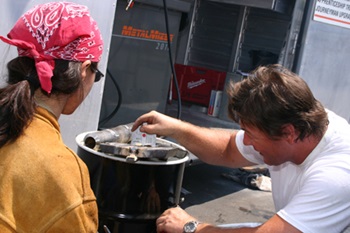 |
Floyd Elliff, Local 263, Dallas, Texas, tests April Finkbonner’s, Local 86, Seattle, Washington, coupon.
|
“If an ironworker has the AWS/Ironworkers National Weld Certification, and everyone knows what they had to go through to get it, there’s a substantial cost savings to the contractor when the owner recognizes the certification card and then can put an Ironworker to work right away on the site,” Abbott said.
There’s more than just a cost savings. Abbott feels that it’s imperative that when an employer calls a union hall and needs five people with a specific skill set that the union respond with highly trained ironworkers. He’s not the only one.
Paul Rose, an owner’s representative for Southern Company, which owns power plants in the Gulf Coast, agrees. Southern Company hires service contractors to work on projects and perform maintenance and retrofit work, and is concerned about developing direct relationships with them.
“The most important concern, of course, is to find skilled, qualified workers to perform the work in the most cost-effective way. The reputation of the ironworkers and their ability to perform is crucial to our company and the contractors we hire,” said Rose.
Rose attended some of the training classes. “It’s far beyond anything that I’ve ever seen with regard to what’s going on in the industry,” he said. “It’s impressive to see the technologies that are improving our industry and how quickly they get down to the individual workers because of the ‘Train the Trainers’ program. This approach takes away the information gap that always seemed to exist.”
The Ironworkers International Union and Miller Electric
“We train the future and Miller has helped us with that for a long, long time,” Abbott said. “Each year, Miller has new products hitting the market, and each July Miller shows up at the program with the latest technology and training. It keeps our guys on the cutting edge. It’s called opportunity, and our members are always looking to learn the latest.”
The relationship works both ways. Miller receives important feedback from the Ironworkers, which helps the company to continue to improve its products and meet the demands of the industry. This means that often those being trained see the latest equipment before anyone else. By the time the equipment hits the field, there is a trained workforce ready to run it.
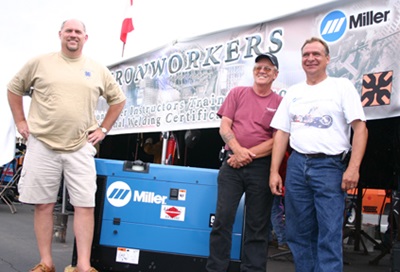 |
Ed Abbot, general organizer with the Ironworkers International Union and manager of the welding program and the National Welding Certification Program, Mike McDonald, business manager for Ironworkers Local 27 in Salt Lake City, and Neal Borchert, business development manager for Miller Electric Mfg. Co., share a common interest: maintain the Ironworkers’ high skill level.
|
The equipment and the training drive each other, and often contractors rely on the ironworkers to tell them of advances that will help them perform their welding tasks more efficiently, faster, smarter and with better quality. Ongoing training helps the whole industry progress.
For instance, Abbott said, an average person may put down 40 lbs. of weld metal in eight hours with FCAW compared to 20 lbs. of weld metal with SMAW. That holds an obvious advantage for the contractor—productivity increases while costs drop. But five or six years ago it could be difficult to find enough ironworkers qualified to weld with AWS E7IT-8 flux cored wire to fill a job, McDonald said. At the time, he’d have 40 people out of work, but couldn’t fill a four-man call for ironworkers certified in that process.
Today, through programs such as “Train the Trainers,” that’s changed. FCAW has quickly become prevalent in the construction industry. Its higher deposition rate makes it an attractive alternative to SMAW, and now approximately 80 percent to 90 percent of the ironworkers are certified in the procedure.
The Ironworkers’ training program has made that growth possible and helped introduce new equipment and technology quicker than ever before. Contractors are able to seek and find qualified Ironworkers who are trained on the same machines they’ll be using in the field.
The Latest Equipment
The equipment the ironworkers trained on this year is quickly becoming the industry’s workhorses. Miller’s XMT 350 CC/CV is a 5- to 425-A, multi-process inverter designed to offer improved productivity, flexibility and weld quality, providing superior arc characteristics in all processes. The XMT 350 features Miller’s unique Auto-Line technology, which provides three key benefits that improve performance:
- The ability to maintain a rock-steady arc despite primary power fluctuations within a 190 to 630V range;
- A primary power draw of just 17.8 amps at rated output on 460 VAC primary—a 25 percent advantage over competitive inverters—making them ideal for constructions sites, which are usually starved for power; and
- The flexibility to accept any type of primary power (190 to 630V, single- or three-phase, 50 or 60 Hz) without any physical linking mechanisms.
Because of their energy efficiency, light weight and compact size, the XMT 350 easily lends itself to rack configurations. Rack systems allow a contractor to concentrate many arcs in one location. They also cost less to maintain and move, since only one rack of lightweight units has to be moved as opposed to six heavier individual power sources or engine drives. The result is increased savings in fuel and labor.
Typically, each welder would use his own welding generator on the site, each of which requires manpower to fuel, takes up space and has to be moved individually. Plus, the noise from six generators can impact both the welders and the surrounding neighborhood.
“But when you’re using an 80- to 100 kw generator and have four or six guys running the inverters, you’re filling up one generator versus five or six diesel machines,” said Josh Kates, general manager and vice president of R.J. Kates, a top supplier of welding equipment for the construction industry.
When running the XMTs from a generator, Kates noticed a fuel savings of about 50 percent compared to individual welding generators. “But it’s not just the fuel savings,” he added. “With individual machines, you’re paying someone to fill them with fuel. Whereas with a large generator, you have a company come in or you do it yourself. You fill it up one time a week. You’re not filling up five or six diesels; you’re filling up one. Considering labor and fuel, the savings are substantial. It’s quieter. You’re using one generator instead of six and you’re getting it 200 or 300 feet from the building.”
The CST 280 Stick/TIG welding power source also readily lends itself to a rack configuration. The CST 280, with its increased welding outputs (5 A to 280 A), lightweight portability and superior SMAW arc characteristics, was designed with the construction industry in mind. This easy-to-operate unit is ideal for stick electrodes up to 3/16” and for TIG welding pipe and plate
Because Ironworkers train on the Miller equipment, contractors can take advantage of the advances the latest technology and know that there are skilled operators there to run it. The “Train the Trainers” program, and Miller’s association with it, is vital to the construction industry’s future.
“We have a powerhouse — 750 megawatts—going up in Pueblo, Colorado, that’s expected to start next spring,” said Jimmy Shasteen of Local 24 in Denver. “Here we are at mid-summer, and by next spring it will be started. There will be a lot of this welding, so this training is going home. I can’t even start to tell you the amount of people who will get trained from what I learned here.